Related Research Articles
John Walker is an English painter and printmaker. He has been called "one of the standout abstract painters of the last 50 years."
Katherine Porter (1941) is an American artist. Born in Cedar Rapids, Iowa in 1941, Porter is considered one of the most important contemporary artists associated with Maine. She resists categorization. Through the medium of painting and drawing her visually stunning canvases convey the conflict inherent in life. She expresses her ideas with a visual vocabulary that is "geometric and gestural, abstract and figurative, decorative and raw, lyric and muscular."
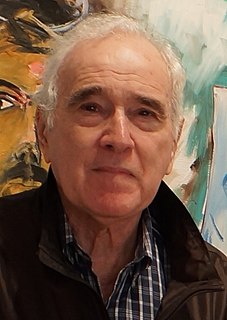
Donald Kuspit is an American art critic and a poet, known for his practice of psychoanalytic art criticism. He has published on the subjects of Avant-garde aesthetics, Postmodernism, Modern art, and Conceptual art.
Dana Frankfort is an artist based in Houston and a painting professor at University of Houston. Her work often engages with the history of abstract art and features bright colors, gestural brushwork, and text.
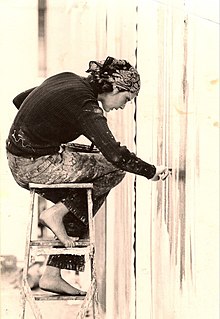
Pat Lipsky is an American painter associated with Lyrical Abstraction and Color Field Painting.

Esther Geller was an American painter mainly associated with the abstract expressionist movement in Boston in the 1940s and 1950s. She was one of the foremost authorities on encaustic painting techniques.
Susanna J. Coffey is an American artist and educator. She is the F. H. Sellers Professor in Painting at the School of the Art Institute of Chicago and lives and works in New York City. She was elected a member the National Academy of Design in 1999.
Włodzimierz Książek was a Polish-born contemporary artist based in New England, and since 2001 worked from a 6000 sq. ft. studio in Rhode Island. He was best known for his large-scale abstract paintings.
The New New Painters were a self-labeled art group whose core members are twelve abstract artists who first came together in 1978 contemporaneously with the further development of acrylic gel paint as developed by the paint chemist Sam Golden. The NewNew Painters as they are called, arose from the roots of Jackson Pollock and Abstract Expressionism, The New York School, and Color Field. The Color Field artists worked by staining on raw canvas, in close value, high key colors, often large scale. The artists of The New New Painters came together with a desire to move forward into a new kind of painting using acrylic gels. Unofficially the group members were exhibiting together in smaller groups up until 1992 when Gerald Piltzer asked Kenworth W. Moffett to curate an exhibition in his new gallery in Paris, France under the name "New New Painting". The term "New New Painting" was coined in a conversation between Graham Peacock and John Gittins and was used by Piltzer for the Paris Show and the hardcover catalog of the same name.
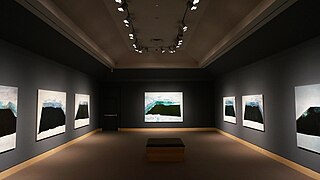
Eric Aho is an American painter living in Vermont. DC Moore Gallery in New York City represents his work.
John Lees is an American contemporary expressionist artist who works primarily in painting.
Boston Expressionism is an arts movement marked by emotional directness, dark humor, social and spiritual themes, and a tendency toward figuration strong enough that Boston Figurative Expressionism is sometimes used as an alternate term to distinguish it from abstract expressionism, with which it overlapped.
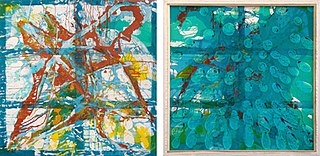
Dona Nelson is an American painter, best known for immersive, gestural, primarily abstract works employing unorthodox materials, processes and formats to disrupt conventional notions of painting and viewership. A 2014 New Yorker review observed, "Nelson gives notice that she will do anything, short of burning down her house to bully painting into freshly spluttering eloquence." Since 2002, long before it became a more common practice, Nelson has produced free-standing, double-sided paintings that create a more complex, conscious viewing experience. According to New York Times critic Roberta Smith, Nelson has dodged the burden of a "superficially consistent style," sustained by "an adventuresome emphasis on materials" and an athletic approach to process that builds on the work of Jackson Pollock. Writers in Art in America and Artforum credit her experimentation with influencing a younger generation of painters exploring unconventional techniques with renewed interest. Discussing one of Nelson's visceral, process-driven works, curator Klaus Kertess wrote, the paint-soaked "muslin is at once the tool, the medium, and the made."

Street Light is a painting by Italian Futurist painter Giacomo Balla, dated 1909, depicting an electric street lamp casting a glow that outshines the crescent moon. The painting was inspired by streetlights at the Piazza Termini in Rome.
Robert Feintuch is an American painter who lives and works in New York City.

Jake Berthot (1939–2014) was an American artist whose abstract paintings contained elements of both the minimalist and expressionist styles. During the first 36 years of his career his paintings were entirely non-figurative. His style changed in 1995 when he moved his studio from New York City to a rural community in upstate New York. While continuing to be abstract his paintings thereafter contained figurative elements and were seen to have greater emotional content. Throughout his career his work frequently appeared in solo and group exhibitions in both commercial and public galleries. It has been collected by the Museum of Modern Art, Metropolitan Museum of Art, Guggenheim Museum, National Gallery of Art, and other major American art museums. He received a Guggenheim Fellowship in 1981 and a National Endowment for the Arts grant in 1983.
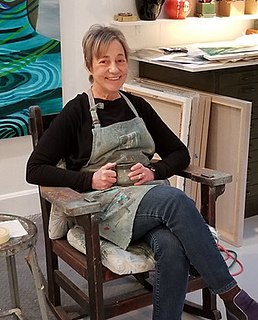
Barbara Grad is an American artist and educator, known for abstract, fractured landscape paintings, which combine organic and geometric forms, colliding planes and patterns, and multiple perspectives. Her work's themes include the instability of experience, the ephemerality of nature, and the complexity of navigating cultural environments in flux. While best known as a painter, Grad also produces drawings, prints, mixed-media works and artist books. She has exhibited in venues including the Art Institute of Chicago, Kemper Museum of Contemporary Art, Danforth Art, Rose Art Museum, Indianapolis Museum of Art and A.I.R., and been reviewed in publications, including Artforum, Arts Magazine and ARTnews. Grad co-founded Artemisia Gallery, one the country's first women-artist collectives, in Chicago in 1973. She has been an educator for over four decades, most notably at the Massachusetts College of Art and Design. Grad has been based in the Boston area since 1987.

John Dilg is an American painter based in the Midwest. He is known for idiosyncratic landscapes created within a pared-down visual vocabulary that draws on memory, imagination, vernacular artifacts, and folk-art and art historical sources. Critics describe them as archetypal, dreamlike ruminations on place, nature and its fragility, the collective unconscious, and mystical storytelling.
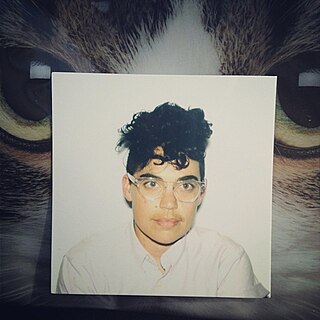
J. R. Uretsky is an artist, performer, musician and art curator living in Providence, Rhode Island.
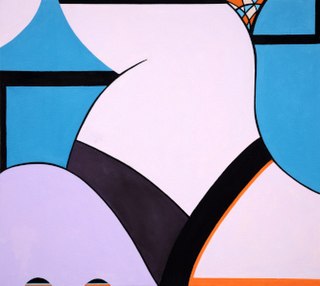
Amanda Church is an American artist known for abstract paintings that reference the human figure and other discernible elements. Her works straddle representational and formalist art traditions, suggesting recognizable body parts, objects, and perspectival elements in an otherwise abstract field. Church's distinctive use of contrasting style elements has been consistently noted by critics such as Hyperallergic's Cora Fisher, who described Church's work as "whimsically overruling the left-right brain dichotomy as well as the traditionally gendered axis that divides geometric and decorative art." Church received a Guggenheim Fellowship in 2015 and a Pollock-Krasner Foundation grant in 2017, among other awards. Her work has been covered in publications such as The New York Times, The Boston Globe, ARTnews, Hyperallergic and Forbes Magazine. Her paintings have been exhibited in major U.S. cities as well as internationally, in galleries and museums such as the Brooklyn Museum of Art and the Aldrich Museum. She lives and works in New York.
References
- ↑ McQuaid, Cate (June 14, 2007). "Still Lifes with a Modern Twist". Boston Globe. Retrieved June 14, 2014.
- ↑ Kuspit, Donald (November 22, 2010). "The New Naturalism". Artnet . Retrieved June 14, 2014.